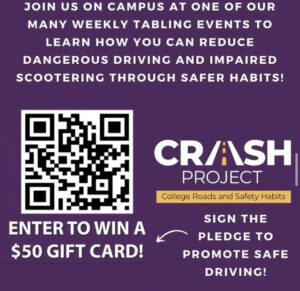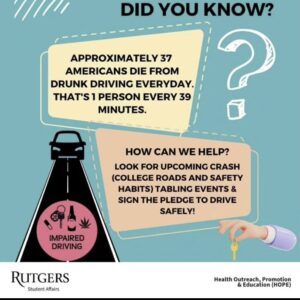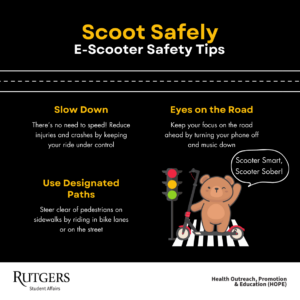Rutgers University-New Brunswick
Scooter Smart, Scooter Sober
How many students heard the message of your project? 100
Project Description:
Description of project objective and its implementation.
The project was designed to increase awareness, promote safety, and encourage responsible behaviors for members of our campus community. As AOD Peer Educators we focused on educating and bringing awareness about College Roads and Safety Habits, and the role of alcohol as a common distraction. We highlighted that whether you are a pedestrian, cyclist, scooterist, or driver, you play an important role in keeping the roads safe. Rutgers is an active campus with packed roads, so this message was integral and important for both undergraduate and graduate students. We also extended our messaging to Rutgers staff, faculty, and all members of the Rutgers community to help make our campus, and their individual communities, a safer place through safer road practices. Although our aim was to create awareness about distracted/impaired driving, sharing the road with all vehicles and individuals, and pedestrian safety, we also addressed the importance of scooter safety. We focused on the issue of intoxicated scootering practices based on reports from local hospitals about injuries from students riding electric scooters that go over 20 mph without helmets on busy college streets. These scooters are a unique and a new addition of transportation to our campus, hence we wanted to encourage students to ride scooters safely. Many students are unaware that riding a scooter while intoxicated could cause similar risks like drinking and driving, so we aimed to raise awareness about this issue.
We decided to implement our campaign by actively engaging in our community through outreach tabling events at the various student centers, and attending college events such as Rutgers Day and a local Public Health movie screening and discussion about the Street Project. We also made educational social media posts about important pedestrian safety, scooter safety, impaired/distracted driving, and sharing the road practices. Lastly, we shared our posts on the Student Health social media accounts.
School/Community Engagement:
How well did they reach their student body and the community? (Examples: connecting with nearby colleges, schools, local police departments, persons affected by crashes, local/county/state officials, local businesses, etc.)
We reached our student body and the community through active engagement and community outreach efforts. We decided to actively engage in our campus community through outreach and tabling events. We collaborated with each Student Center on all five New Brunswick campuses, and participated in larger scale events such as Rutgers Day and The Street Project Film screening and discussion hosted by the Bloustein School of Planning and Public Policy. In addition, we also communicated the message of this project to all students via the Rutgers Student Health Instagram Account via a partnership with Rutgers Student Health Marketing. We also collaborated with RU SURE, a student organization, that conducts a dangerous drinking prevention campaign. This organization in conjunction with an independent research study course in the School of Communications shared the CRASH project and pledge with their students and collaborated and partnered with us for a culminating prevention and education event on Rutgers Day.
Creativity:
Description of their creative process. What makes their project unique and engaging? (Examples: create artwork, music, plays, unique campaign slogan/logos, etc.)
Our project was unique and engaging because we created our own social media posts and created stickers for the campaign. We collaborated with other student groups on campus to reach more students with our messaging. Our campaign slogan, “Scooter Smart, Scooter Sober”, was used to create a sticker that students could put on their laptop, water bottles, skateboards, cars, etc. to share the message of safe scootering practices in an active or passive way. The sticker also had a logo of a bear riding a scooter which served as our campaign mascot. During our outreach tabling events, we took a life size stuffed bear (Big Red) with us for students to take pictures with and receive “free hugs” after signing our pledge to share the road. This helped students engage with the campaign’s message as they shared the picture of the oversized bear with their friends, and encouraged them to visit our table to do the same. The logo of our bear mascot was also featured on our social media posts related to scooter safety so that students who visited our outreach events could spot a familiar face on the student health Instagram account. We then collaborated with a student-led dangerous drinking prevention campaign at Rutgers through the School of Communications called RU SURE. Upon introducing our CRASH campaign to this student organization, they invited us to join them during Rutgers Day on April 27th in collaboration with RUPD, the Rutgers Recovery House, and Graduate School of Applied and Professional Psychology for an outreach event. At Rutgers Day, we engaged with students, staff, faculty, alumni, families, and the entire Rutgers community to raise awareness about sharing the road, both on and off-campus, along with safe practices on the road as pedestrians, cyclists, drivers, and scooterists.
Use of Resources:
Use of resources to help identify, deliver, assess, and present their project. (Examples: utilizing local/statewide/national data, newspapers, social media, podcasts, etc.)
Some resources we used to help identify, deliver, assess, and present our project was through Residence Life bulletin boards, social media, classrooms, and attending clubs and organizations. By decorating Resident Assistant boards in dorm hallways that promote safe driving habits, we attached safe driving habit information related to pedestrian safety in addition to the QR code for the pledge as well. In addition, we met with RU Sure on campus to collaborate with them on Rutgers Day to spread awareness about the campaign. We also decided to create Social media posts on Instagram throughout the semester as well that focused on important pedestrian safety, scooter safety, impaired/distracted driving, and sharing the road habits. We conducted outreach tabling each Tuesday from February 6th to April 16th across the five student centers on the university campus to engage in discussions with students about road safety and encourage them to sign a pledge to share the road. At these tabling sessions, we shared resources like blood alcohol content calculators, signs of alcohol poisoning/steps to take, and stickers encouraging all to “scooter smart, scooter sober”. We provided an opportunity for students to share their knowledge and learn new facts about sharing the road, pedestrian safety, scooter safety, and road safety practices through a spin the wheel activity where they would answer a question for a chance to win a prize (candy, pen, sticker).
Evaluation and Impact:
Description of how they measured community engagement (examples: pre/post observational studies, focus groups, surveys, polls/quizzes, interviews, etc.)
We measured community engagement through the amount of pledges at each tabling session/event, in addition to the amount of supplies that we initially started with versus the amount we had left after each session, such as our “Scooter Smart, Scooter Sober” stickers. We offered each student that stopped by our outreach events an item that re-enforced the messaging. We also measured data analytics by by monitoring the amount of likes we received on the social media posts we shared on the Rutgers Student Health Instagram. We were able to receive over 100 likes on our CRASH themed messaging. In addition, we were able to use our engagement tools to assess what level of awareness students had prior to coming to the table and after leaving the table based on their responses to the spin the wheel activity at each event.
PROJECT MEDIA











